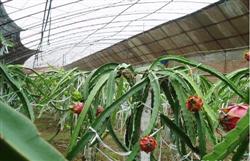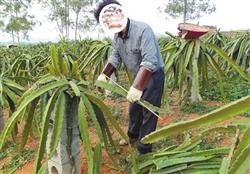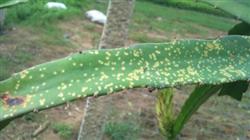How to grow dragon fruit in greenhouse

1. The construction of greenhouse can adopt "Langfang 40 solar greenhouse", which has the characteristics of high light transmittance, strong thermal insulation and low construction cost. The greenhouse covers an area of 80m from east to west and 18m from north to south. The greenhouse facing south by west of 5 °~ 100 °is favorable for daylighting. The height of the back wall of the greenhouse is 2.8m, the width of the bottom is 4.5m, the width of the top is 2m, the lower seat is 0.7m, the highest point of the east-west gable is 3.5m, the thickness of the wall is 2cm 3m, and the span in the greenhouse is 7.25m. Greenhouse wall construction can use mechanical operation, each cushion 40~50cm, compaction 6 times, about 4 layers of soil, and then manual repair, so that the inner wall is straight, the outer wall is gentle, solid and solid. An iron arch beam is placed every 1.5m. The arch beam is mainly supported by the middle column and the front and rear fixed piles. The projection of the rear roof is 0.8m and the inclination angle is 45 °. 1.2m deep anchor ditches were dug on the east and west sides of the greenhouse, with 23 anchors on each side. The front and rear slopes were strung with 23 channels of No. 8 galvanized wire, including 16 on the front slope and 7 on the back slope. 30cm thick corn stalks were laid on the back slope, and 30cm was covered with corn stalks. Qianpo string cable is fixed with a 7m bamboo pole as an arch, then covered with polyvinyl chloride non-dripping film, and then pressed with a pressing film line to cover 4cm thick grass grass in early winter, with a coverage of 150% Kraft paper from January to February, with a coverage of 110%. In case of snow, a layer of old film should be covered to prevent the grass from being too wet to affect heat preservation. Second, seedling planting pitaya belongs to vine cactus family, which must be set up for climbing and growth when cultivated artificially. First of all, 305 1.3m high cement piles were buried in the greenhouse according to the plant spacing of 1.2m and the row spacing of 1.5m, and two dragon fruit seedlings were planted with each cement pile. Before planting, 12 cubic meters of crude fertilizer was applied in each greenhouse, diammonium phosphate 50kg was used as base fertilizer, and enough planting water was poured after planting. Third, cultivation and management 1. Watering dragon fruit is a drought-tolerant plant, generally, the soil relative water content reaches 70% to 80%, it can grow normally, but the waterlogging tolerance is poor, such as long-term stagnant water in the roots, it will cause rotten roots to reduce production or death, and it is necessary to grasp the principle of not drying and watering when watering. In addition, in the process of growth, the fruit should not be watered when it is not sitting, and it should be watered again when the fruit grows to the size of the egg, usually once every 15-20 days. two。 Due to the vigorous growth and annual results of dragon fruit, more fertilizer is needed. In order to ensure the fruit quality and yield, we must adhere to the principle of organic fertilizer and chemical fertilizer. In the case of sufficient base fertilizer, topdressing should be done every 15 to 20 days after entering the fruiting period, and attention should be paid to the cross between organic fertilizer and chemical fertilizer. Attention should be paid to balanced fertilization to ensure complete nutrients and fully meet the needs of plants for all kinds of nutrients. There are many methods of topdressing, such as ring topdressing, radial topdressing, irrigation topdressing and foliar topdressing. The root system of dragon fruit is different from other fruit trees, there is no strong main root, it is whisker root, and the root system is very shallow, which is basically distributed in the surface layer of soil. Therefore, special attention should be paid not to damage the root system when topdressing. 3. After the whole pitaya seedlings were planted, they could germinate and grow rapidly after about 15-20 days. In the growth process will breed a lot of buds, the formation of disorderly lateral branches, if not pruned in time, it will affect the normal growth of the plant. When the dragon fruit is pruned, only one trunk is left, and all the other lateral branches are cut off to ensure the normal growth of the trunk. When the trunk reaches 1.3 to 1.5m high (the trunk height should be about 1m when cultivated as potted flowers), topping should be carried out to force it to produce lateral branches. these lateral branches are fruiting branches. According to the status of plant growth and environmental conditions, about 20 fruiting branches can be left per plant. It is advisable to leave 3 fruits for one fruiting branch. If the fruit setting distance is less than 15cm, one of the weak fruits can be removed to ensure the normal growth of other fruits. After entering the full fruiting period, all fruiting branches should be cut off to reduce nutrient consumption. Fourth, pest control pitaya is wild in its original producing area and has a strong ability to resist diseases and insect pests. After being introduced into our country, no serious diseases and insect pests have been found, but snails and slugs often nibble on its tender branches, which affect the growth of pitaya. Generally, lime control can be used, such as when the population density is high, poison bait can also be used. When the fruit is ripe, the fruit fly often lays eggs in the fruit epidermis, resulting in fruit cracking and rotten fruit. The control method is to hang sticky fly paper on the branches, trap and kill flies, or spray with biological pesticide "Qianchongg" 800 times liquid, the effect is also ideal. Click to see more dragon fruit planting techniques
- Prev

What are the fertilizer characteristics of dragon fruit?
The pruning of fruit trees can adjust the structure of population and individual parts, improve the light utilization conditions, adjust the overall growth of fruit trees by using the dynamic balance law of aboveground and underground parts, and adjust the quantity, quality and rhythm of organ formation. Harmony between growth and fruiting, aging and rejuvenation, and the various parts of the tree, each...
- Next

What are the main pests of dragon fruit
Pine trees have been planted in orchards before, and termites may be more serious. Termites will directly gnaw off the stem of the dragon fruit plant or nibble away at the root group, causing the injured tissue to yellowing and fester upward. The control of termites can be killed by drugs in the roots. Underground pests include snails, slugs, ants and so on. They eat the tender branches of plants. But in.
Related
- Moge, come on! The staff of the peasant association in the producing area of cantaloupe were frightened when the crowd gathered.
- Causes and Solutions of low Fruit setting rate of Apple
- Symptoms and control measures of passion fruit virus disease
- Fruit growing lesson: how do apple orchards keep high yields?
- Can you build orchards in the mountains? What are the pros and cons?
- How to manage the coloring period of Crisson grape?
- This paper introduces the processing technology of two kinds of fig products.
- How much is a month for retired teachers in rural areas by 2020?
- How can strawberry planting increase sugar content? We should pay attention to management in many aspects.
- What are the cultivation techniques on how to improve the yield of golden fruit?

